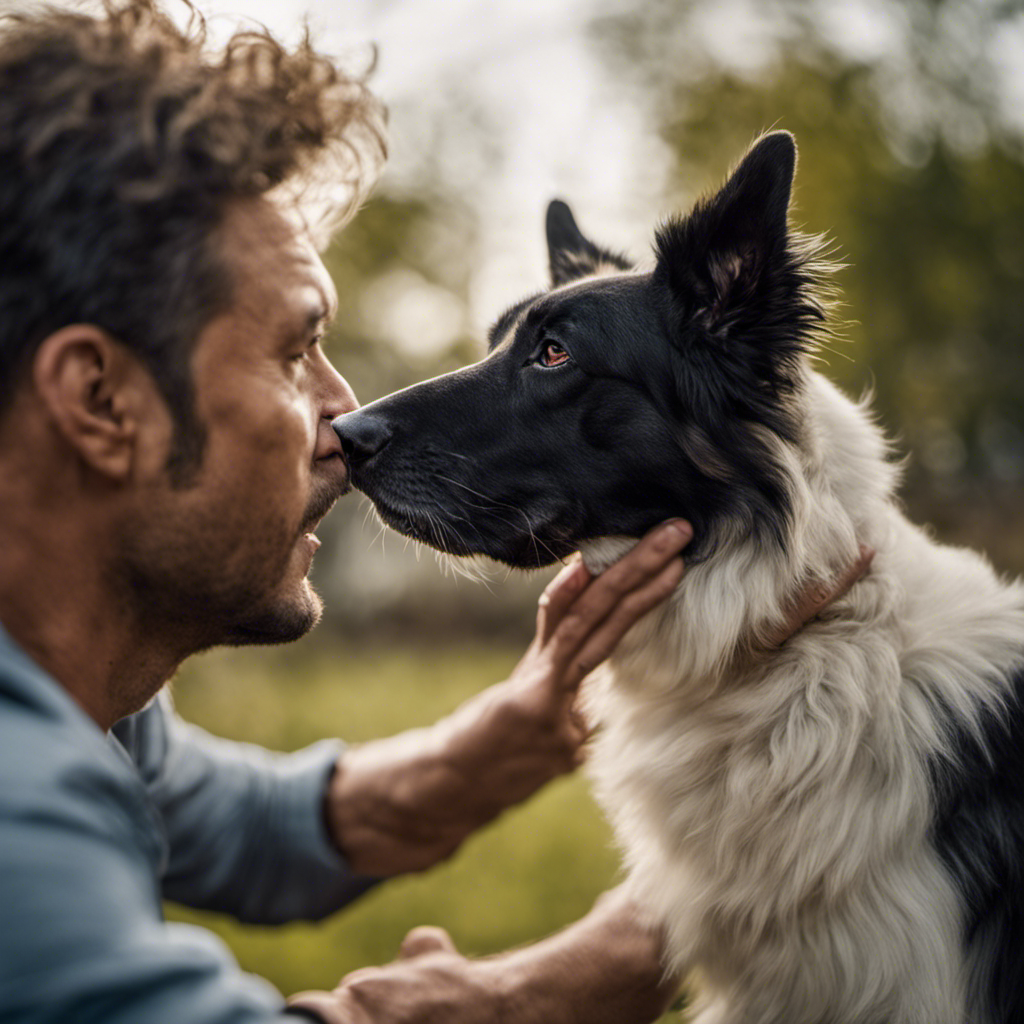- Key Takeaways
- The Importance of 'Ascolta' in Dog Training
- How to Teach Your Dog to 'Ascolta
- Common Challenges When Teaching 'Ascolta' and How to Overcome Them
- Using 'Ascolta' to Improve Off-Leash Control
- Ascolta' as a Foundation for Advanced Commands
- Incorporating 'Ascolta' Into Everyday Situations
- Ascolta' in Different Environments: Indoor Vs Outdoor Training
- The Benefits of Using Italian Dog Commands in Training
Click and GO TO THE BEST DOG NAME GENERATOR HERE

You think you’ve tried every trick in the book to get your dog to listen, but have you considered using Italian commands?
One phrase that can make a world of difference in your dog training is ‘Ascolta’ which means ‘Listen’ in Italian.
In this article, we’ll explore the importance of incorporating ‘Ascolta’ into your training routine, how to teach your dog this command, and the benefits of using Italian dog commands overall.
Get ready to take your dog’s obedience to a whole new level!
- Key Takeaways
- The Importance of 'Ascolta' in Dog Training
- How to Teach Your Dog to 'Ascolta
- Common Challenges When Teaching 'Ascolta' and How to Overcome Them
- Using 'Ascolta' to Improve Off-Leash Control
- Ascolta' as a Foundation for Advanced Commands
- Incorporating 'Ascolta' Into Everyday Situations
- Ascolta' in Different Environments: Indoor Vs Outdoor Training
- The Benefits of Using Italian Dog Commands in Training
Key Takeaways
- Reinforcing ‘Ascolta’ improves communication and obedience in dog training.
- Creating a distraction-free environment and using clear gestures helps improve focus during training.
- Positive reinforcement, such as praise and treats, is essential in teaching ‘Ascolta’.
- Training ‘Ascolta’ can enhance off-leash control and increase freedom during outdoor activities.
The Importance of ‘Ascolta’ in Dog Training
You should prioritize reinforcing the command ‘Ascolta’ in your dog training to enhance communication and obedience. Improving focus during training is crucial for effective communication between you and your furry friend.
‘Ascolta’ teaches your dog to listen and pay attention to your commands, resulting in a more obedient and well-behaved pet. To improve focus, start by eliminating distractions in the training environment. Find a quiet space where your dog can concentrate without being easily distracted.
Additionally, using body language plays a significant role in ‘Ascolta’ training. Dogs are highly responsive to visual cues, so utilize clear and consistent gestures to accompany the verbal command. Maintain eye contact with your dog and use hand signals that are easily recognizable.
How to Teach Your Dog to ‘Ascolta
Teaching your dog to ‘Ascolta’ or listen is an essential command for effective communication. Start by using a firm but gentle tone and saying ‘Ascolta’ while making eye contact with your dog.
When your dog responds by focusing their attention on you, reward them with praise or a treat to reinforce the behavior.
Effective Listening Techniques
Pay close attention to the speaker’s words to ensure you understand and retain the information effectively.
When it comes to training your dog, reducing distractions is key. By creating an environment that’s free from noise and other disturbances, you can focus on building trust and rapport with your furry companion. Limiting distractions during training sessions allows your dog to fully concentrate on the commands and signals you’re providing. This not only helps them learn faster but also strengthens the bond between you and your dog.
Remember to establish a calm and quiet space for training, away from loud noises or busy areas. Additionally, using positive reinforcement techniques such as treats or praise can help motivate your dog and reinforce their learning. By reducing distractions and building trust, you can create a successful training experience for both you and your dog.
Reinforcing Listening Behavior
Your dog’s listening behavior can be reinforced by using positive reinforcement techniques, such as treats or praise. When your furry friend responds to your commands and pays attention, it’s important to reward them as this encourages them to continue listening.
Rewards for listening behavior can include small treats that your dog finds enticing or verbal praise accompanied by a pat on the head. By consistently rewarding your dog for their attentive behavior, you’re teaching them that listening to you is a positive experience.
Furthermore, training tips for distracted dogs involve creating a distraction-free environment during training sessions, using high-value treats to capture their attention, and breaking down commands into smaller, manageable steps.
Common Challenges When Teaching ‘Ascolta’ and How to Overcome Them
You should know that some of the common challenges when teaching ‘Ascolta’ include distracted dogs and lack of focus, but these can be overcome with consistent training and positive reinforcement.
Distractions can be a major hurdle when teaching any command to your dog, and ‘Ascolta’ is no exception. Dogs are naturally curious animals, and it can be difficult for them to ignore the sights, sounds, and smells around them. To overcome this challenge, it’s important to maintain consistency in your training sessions. Find a quiet and familiar environment where your dog can focus on you and the command. Start with short training sessions and gradually increase the duration as your dog becomes more attentive.
Another challenge when teaching ‘Ascolta’ is breaking down the command into smaller steps. Dogs learn best when commands are introduced gradually. Begin by teaching your dog to make eye contact with you on cue. Once this is mastered, move on to teaching the command ‘Ascolta’ with a hand signal or verbal cue. Reward your dog with praise or treats when they respond correctly. Positive reinforcement is key in training ‘Ascolta’. Dogs are more likely to repeat behaviors that are rewarded, so be generous with your praise and rewards.
Using ‘Ascolta’ to Improve Off-Leash Control
To improve off-leash control with your dog, using the command ‘Ascolta’ can be highly effective.
By teaching your dog to listen and respond to this command, you can establish clear communication and enhance your bond as a dog-owner.
With consistent training and positive reinforcement, your dog will learn to pay attention and follow your commands even without a leash, providing you with a greater sense of control and freedom during walks and outdoor activities.
Effective Off-Leash Communication
Listen up, utilizing ‘Ascolta’ will greatly improve your off-leash communication skills. When it comes to effective off-leash communication, rewards-based training and understanding body language communication are key. By using positive reinforcement techniques, such as treats and praise, you can encourage your dog to listen and respond to your commands. This creates a strong bond between you and your furry friend, making off-leash training more successful. Additionally, paying attention to your dog’s body language is crucial in understanding their needs and emotions. A wagging tail may indicate happiness, while a lowered posture could mean fear or submission. By being aware of these cues, you can better communicate with your dog and ensure a safe and enjoyable off-leash experience for both of you.
| Rewards-Based Training | Body Language Communication |
|---|---|
| Encourages positive behavior by rewarding desired actions | Helps interpret your dog’s emotions and needs |
| Builds trust and strengthens the bond between you and your dog | Allows for effective communication without words |
| Provides motivation and incentive for your dog to listen and obey | Helps prevent misunderstandings and potential conflicts |
Enhancing Dog-Owner Bond
By practicing ‘Ascolta’ during off-leash training, you can deepen the dog-owner bond and enhance control over your furry companion. Ascolta, which means ‘listen’ in Italian, is a crucial command that improves communication and builds trust between you and your dog.
When your dog learns to listen and respond to this command, it not only strengthens the bond but also ensures their safety and your control in potentially dangerous situations. The act of listening requires attention, focus, and understanding, which are all essential qualities in a well-trained dog.
Through consistent practice and positive reinforcement, you can establish a strong foundation of trust and obedience with your furry friend. So, incorporate ‘Ascolta’ into your off-leash training sessions and witness the remarkable transformation in your dog’s behavior and your relationship with them.
Ascolta’ as a Foundation for Advanced Commands
Did you know that ‘Ascolta’ serves as the foundation for advanced commands in Italian dog training?
Ascolta, which means ‘listen’ in Italian, is a crucial command that reinforces listening behavior and enables effective off leash communication between you and your furry friend.
When teaching your dog to ‘Ascolta,’ it’s important to establish a strong foundation of basic obedience commands such as sit, stay, and come. Once your dog has mastered these commands, you can begin incorporating ‘Ascolta’ into your training routine.
To start, find a quiet and distraction-free area to work with your dog. Begin by saying the command ‘Ascolta’ in a clear and firm voice. As your dog turns their attention towards you, reward them with praise and a treat. Gradually increase the distance between you and your dog, making sure they continue to respond to the command. This will help develop their ability to listen and follow instructions even when they’re off leash.
By reinforcing listening behavior through the command ‘Ascolta,’ you’re laying the groundwork for more advanced commands in Italian dog training. This command not only enhances your dog’s obedience, but also strengthens the bond between you and your furry companion.
Incorporating ‘Ascolta’ Into Everyday Situations
When you’re out for a walk with your dog, remember to use ‘Ascolta’ to reinforce their listening skills. Incorporating ‘Ascolta’ into your daily walks is a great way to prevent unwanted behaviors and create a stronger bond with your furry friend.
Using ‘Ascolta’ during your walks can help redirect your dog’s attention and prevent them from engaging in unwanted behaviors such as pulling on the leash or chasing after squirrels. By teaching your dog to listen and respond to the command ‘Ascolta’, you’re establishing yourself as the leader and showing them that you’re in control.
To incorporate ‘Ascolta’ into your walks, start by using it when you want your dog to pay attention to you. Say their name followed by ‘Ascolta’ in a calm and assertive tone. When they turn their attention towards you, reward them with praise or a treat. Repeat this process throughout your walk, gradually increasing the distractions to further challenge their listening skills.
By consistently using ‘Ascolta’ during your walks, you aren’t only reinforcing their obedience but also providing mental stimulation. This can help prevent boredom and destructive behaviors that may arise from a lack of mental exercise.
Ascolta’ in Different Environments: Indoor Vs Outdoor Training
Remember to switch up your training routine by incorporating ‘Ascolta’ both indoors and outdoors, so your dog can practice listening in different environments.
Indoor training techniques provide a controlled setting where you can focus on teaching your dog to listen and respond to commands without any external distractions. This is especially beneficial for puppies or dogs who are just starting their training journey. Start by finding a quiet, well-lit area in your home where you can work with your dog. Use positive reinforcement techniques, such as treats or praise, to reward your dog for listening and following commands. As your dog becomes more proficient, gradually increase the level of difficulty by introducing distractions like toys or other family members.
On the other hand, outdoor training exposes your dog to various distractions, such as other animals, people, and noises. This helps your dog learn to listen and follow commands even in the presence of distractions. Begin by choosing a familiar and safe outdoor location, such as your backyard or a nearby park. Start with simple commands, like ‘sit’ or ‘stay’, and gradually progress to more challenging commands. Keep sessions short and engaging to maintain your dog’s focus. Use a leash or long line to ensure your dog’s safety and prevent them from running off. Remember to reward and praise your dog for their achievements.
The Benefits of Using Italian Dog Commands in Training
You can enhance your dog’s training by incorporating Italian dog commands, like ‘Ascolta’, which can help improve their responsiveness and obedience. Italian dog commands have been used for centuries and have proven to be effective in training dogs of all breeds and sizes.
Here are some benefits of using Italian dog commands in your training:
-
Consistency: Using Italian commands provides a clear and consistent language for you to communicate with your dog. This can help eliminate confusion and make the training process smoother.
-
Multi-dog households: If you have multiple dogs in your household, using Italian commands can help differentiate between each dog’s training. Each dog can have their own unique command, making it easier for them to understand what’s expected of them.
-
Agility training: Incorporating ‘Ascolta’ into agility training can be especially beneficial. This command can help your dog focus and listen to your instructions, which is crucial in agility courses where quick reactions and precise movements are required.
-
Cultural connection: Using Italian dog commands adds a touch of culture and uniqueness to your training sessions. It can be a fun and interesting way to bond with your dog while teaching them new skills.
- Key Takeaways
- The Importance of 'Ascolta' in Dog Training
- How to Teach Your Dog to 'Ascolta
- Common Challenges When Teaching 'Ascolta' and How to Overcome Them
- Using 'Ascolta' to Improve Off-Leash Control
- Ascolta' as a Foundation for Advanced Commands
- Incorporating 'Ascolta' Into Everyday Situations
- Ascolta' in Different Environments: Indoor Vs Outdoor Training
- The Benefits of Using Italian Dog Commands in Training


